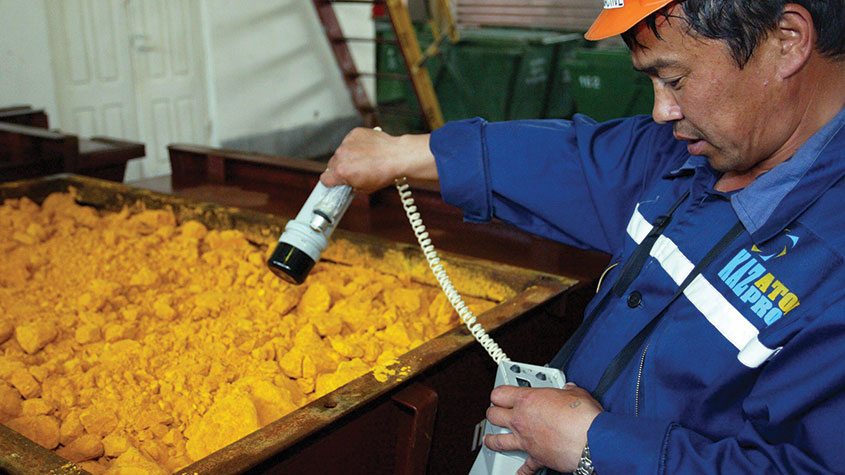The best ways to buy strategic metals
Weaker prices for strategic metals in the alternative-energy sector are an investment opportunity, says David Stevenson. Here, he picks some of the best ways to buy in.


Given the increase in wholesale gas prices you’d expect that investment vehicles and companies involved in the energy transition would have shot up in value. However Tesla’s share price is down by almost a third (-31%) in the year to date, while Umicore, a major player in recycling strategic metals, is down 13%. As for funds, L&G Battery Value-Chain ETF (LSE: BATT) has fallen 18% in the year to date while WisdomTree Battery Solutions ETF (LSE: VOLT) is down 21% over the same period.
The share prices of nuclear energy-related firms have also not moved that much given the renewed focus on nuclear. Yellow Cake (LSE: YCA), a London-listed uranium oxide physical holding company, has seen its share price advance by 20% in the year to date. However, Geiger Counter (LSE: GCL), which invests in uranium-exploration companies, has seen its share price fall by 3%.
There’s also a handful of newly listed uranium ETF trackers. HANetf partnered with Canadian commodities giant Sprott to launch the HANetf Sprott Uranium Miners ETF (LSE: URNP), while Global X launched Uranium ETF (LSE: URNG). Over the last three months these funds have increased by between 24% and 16% respectively. Those numbers are certainly an improvement on the S&P 500’s decline of 4% but they’re hardly off to the races.
MoneyWeek
Subscribe to MoneyWeek today and get your first six magazine issues absolutely FREE

Sign up to Money Morning
Don't miss the latest investment and personal finances news, market analysis, plus money-saving tips with our free twice-daily newsletter
Don't miss the latest investment and personal finances news, market analysis, plus money-saving tips with our free twice-daily newsletter
Buoyant battery market will be good for strategic metals
Part of the reason for these mediocre returns is that investors in the battery complex and nuclear-power spectrum have grown jittery about over-capacity and some short-term price weakness in key metals. Chinese nickel-sulphate prices peaked at RMB56,000 per metric tonne on 10 March, but have come down around 34% to RMB36,900/mt as of 12 July, according to Scott Yarham at S&P Global Commodity Insights. One contributory factor has been the weakness of the steel sector in China – which accounts for more nickel demand than batteries, resulting in lower overall demand.
However, this analysis also points to a much more buoyant overall battery market. Lithium carbonate hit all-time highs of $78,000/mt in April and at S&P’s recent assessment was at $71,000/mt, up nearly 450% year on year due to increased demand for electric vehicle batteries and tight supply.
Cobalt hydroxide prices have also increased nearly 32% year on year, while battery-pack costs have increased and battery makers have made public announcements that prices will increase, says Yarham. “This is very unusual for battery costs, which have been consistently moving down for over a decade.” Some lithium producers are said to be fully booked for 2022.
Electric-vehicle growth will strain mining capacity
Short-term pricing pressures aside, it seems to me markets haven’t priced in long-term structural drivers. There will be a huge increase in electric vehicle deliveries over the next decade. This will strain mining capacity, especially in lithium. Prices must rise to stimulate investment in new capacity.
That’s also true for the uranium sector but with an added twist. Most deals avoid the spot market for uranium and opt for longer-term contracts. However capacity constraints will arise as demand from the developing world increases, forcing public sector buyers into the spot markets, which are thinly traded.
Finally, both the battery complex and nuclear sector lack the capacity to refine raw materials. Too much lithium-processing capacity is in China and uranium processing in Kazakhstan and Russia. If these countries were to use this capacity for geostrategic ends, prices would jump.
In short, if you think we are embarking on a structural transformation to wean us off increasingly expensive hydrocarbons, then recent price weakness in these alternative energy niches might represent a real opportunity.
Get the latest financial news, insights and expert analysis from our award-winning MoneyWeek team, to help you understand what really matters when it comes to your finances.

David Stevenson has been writing the Financial Times Adventurous Investor column for nearly 15 years and is also a regular columnist for Citywire.
He writes his own widely read Adventurous Investor SubStack newsletter at davidstevenson.substack.com
David has also had a successful career as a media entrepreneur setting up the big European fintech news and event outfit www.altfi.com as well as www.etfstream.com in the asset management space.
Before that, he was a founding partner in the Rocket Science Group, a successful corporate comms business.
David has also written a number of books on investing, funds, ETFs, and stock picking and is currently a non-executive director on a number of stockmarket-listed funds including Gresham House Energy Storage and the Aurora Investment Trust.
In what remains of his spare time he is a presiding justice on the Southampton magistrates bench.
-
 My 6.5% Nationwide regular saver is due to mature - what are my options?
My 6.5% Nationwide regular saver is due to mature - what are my options?Nationwide’s 6.5% regular saver is due to mature for those who opened one last year. Here is what you can do now to make the most of your savings
-
 Leading European companies offer long-term growth
Leading European companies offer long-term growthOpinion Alexander Darwall, lead portfolio manager, European Opportunities Trust, picks three European companies where he'd put his money
-
 Halifax: House price slump continues as prices slide for the sixth consecutive month
Halifax: House price slump continues as prices slide for the sixth consecutive monthUK house prices fell again in September as buyers returned, but the slowdown was not as fast as anticipated, latest Halifax data shows. Where are house prices falling the most?
-
 Rents hit a record high - but is the opportunity for buy-to-let investors still strong?
Rents hit a record high - but is the opportunity for buy-to-let investors still strong?UK rent prices have hit a record high with the average hitting over £1,200 a month says Rightmove. Are there still opportunities in buy-to-let?
-
 Pension savers turn to gold investments
Pension savers turn to gold investmentsInvestors are racing to buy gold to protect their pensions from a stock market correction and high inflation, experts say
-
 Where to find the best returns from student accommodation
Where to find the best returns from student accommodationStudent accommodation can be a lucrative investment if you know where to look.
-
 The world’s best bargain stocks
The world’s best bargain stocksSearching for bargain stocks with Alec Cutler of the Orbis Global Balanced Fund, who tells Andrew Van Sickle which sectors are being overlooked.
-
 Revealed: the cheapest cities to own a home in Britain
Revealed: the cheapest cities to own a home in BritainNew research reveals the cheapest cities to own a home, taking account of mortgage payments, utility bills and council tax
-
 UK recession: How to protect your portfolio
UK recession: How to protect your portfolioAs the UK recession is confirmed, we look at ways to protect your wealth.
-
 Buy-to-let returns fall 59% amid higher mortgage rates
Buy-to-let returns fall 59% amid higher mortgage ratesBuy-to-let returns are slumping as the cost of borrowing spirals.